Occupational Shifts: Who Will Need to Change
Impact of Automation
Occupational Shifts: Who Will Need to Change?
Understanding the Impact of Automation on Occupational Shifts
As the world stands on the brink of unprecedented technological change, the global workforce is at a critical juncture. We’re not just looking at the next stage of industrial evolution—what we’re facing is a seismic shift that will redefine entire professions, job categories, and the very nature of work itself. AI, automation, robotics, and the rapidly advancing field of biotechnology, particularly through CRISPR, are converging to create a future where traditional roles may either evolve drastically or disappear altogether. Understanding which occupations are most at risk, how varying levels of automation adoption will impact these changes, and the critical role of workforce mobility in navigating this transformation will be crucial for both workers and business leaders alike.
Mustafa Suleyman’s The Coming Wave outlines this massive disruption in vivid detail, emphasizing that we’re entering an era where the pace of change will be relentless and transformative. Suleyman argues that this shift won’t just impact a few industries—it will fundamentally alter the global labor market and the socioeconomic fabric of our society. In this blog, we’ll engage in a thought experiment to explore which job categories will be most affected and how individuals can position themselves to adapt and thrive amidst this evolution
A Glimpse into the Future: AI and Robotics Transforming Disaster Recovery
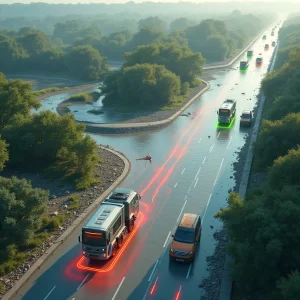 What If? Imagine this Future
What If? Imagine this Future
Envision how much differently emergency response could be in an AI centric future. Here is a thought experiment to illustrate this potential tomorrow.
It is the year 2044, and the southeastern United States has just experienced the full force of a massive storm like Hurricane Helene of 2024. A Category 5 hurricane that brought unprecedented devastation to areas of western North Carolina and the surrounding states. Trees are uprooted, power lines downed, and entire towns are submerged. The remnants of buildings, cars, and infrastructure lie scattered across the landscape, leaving tens of thousands without homes or basic necessities.
In the past, such a disaster would have resulted in months of slow recovery, marred by the inefficiencies and delays of various government agencies like FEMA and local authorities.
But not this time:
This time the response is handled by a new, AI-driven system that not only accelerates recovery but also anticipates and prevents many of the problems that have historically plagued disaster response efforts.
The Future Response: AI and Robotics in Action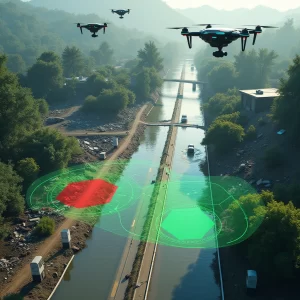
In this scenario, the federal government has partnered with private tech companies to create the National Emergency Response and Resilience Initiative (NERRI), a program that leverages AI, robotics, and automation to orchestrate a unified response to natural disasters. As soon as Hurricane Helene passes, a sophisticated General Artificial Intelligence takes command, coordinating thousands of autonomous drones, utility repair robots, and AI-driven supply chain systems to execute a recovery plan with the precision and speed that no human-led operation could achieve.
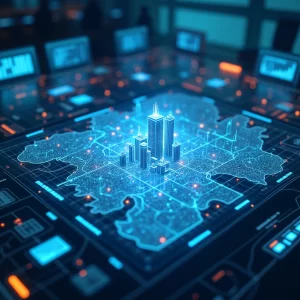 The GAI-Controlled Disaster Command Center
The GAI-Controlled Disaster Command Center
At the heart of this effort is a General Artificial Intelligence Disaster Command Center. With access to real-time data from a vast network of IoT devices, satellite imagery, drone footage, and emergency communication channels, the GAI rapidly assesses the extent of the damage, identifying critical areas in need of immediate intervention.
•Real-Time Analysis: Within minutes of the storm’s passing, the GAI has a complete, 3D model of the affected areas, highlighting downed power lines, blocked roads, collapsed buildings, and flooded neighborhoods.
•Prioritization and Deployment: The GAI instantly prioritizes rescue and recovery efforts based on urgency, population density, and vulnerability, deploying resources to the hardest-hit areas first.
•Predictive Modeling: Using predictive analytics, the GAI anticipates secondary hazards such as landslides, dam failures, and disease outbreaks, allowing preemptive measures to be implemented before these threats materialize.
Restoring Power and Water: Autonomous Utility Robots at Work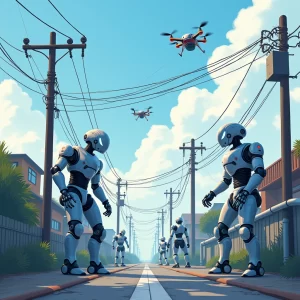
In the aftermath of a major hurricane, restoring essential utilities like power and water can take weeks or even months. In 2044, however, an army of Autonomous Utility Repair Robots works around the clock to get communities back online.
•Power Restoration: Equipped with advanced hydraulic arms, AI-powered sensors, and precision tools, these robots can navigate debris-covered terrain, repair downed power lines, and rebuild damaged substations without human intervention. While human utility crews typically take days to restore power to a small town, these robots complete the job in hours, with entire regions back online within 48 hours of the storm’s departure.
•Water and Sanitation: Flooding often disrupts water treatment facilities and contaminates water supplies. Autonomous robots, equipped with high-efficiency water filtration units and leak detection sensors, can quickly identify and repair damaged pipelines. They also deploy portable water purification systems to provide clean drinking water to affected communities.
Search and Rescue: AI-Powered Drones Locate and Aid Survivors
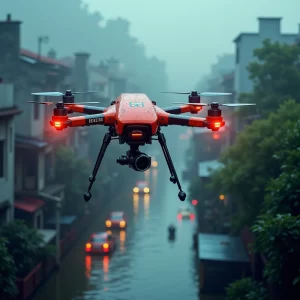 One of the most critical tasks following a disaster is locating and rescuing stranded survivors. In this future scenario, a swarm of AI-Powered Search and Rescue Drones is launched within minutes of the storm’s passing. These drones, equipped with thermal imaging cameras, LIDAR sensors, and real-time communication links, perform coordinated search patterns over vast areas.
One of the most critical tasks following a disaster is locating and rescuing stranded survivors. In this future scenario, a swarm of AI-Powered Search and Rescue Drones is launched within minutes of the storm’s passing. These drones, equipped with thermal imaging cameras, LIDAR sensors, and real-time communication links, perform coordinated search patterns over vast areas.
•Survivor Detection: The drones identify heat signatures and other signs of life, relaying precise GPS coordinates to nearby rescue teams or larger autonomous rescue bots.
•First Aid Delivery: For those trapped in remote or inaccessible locations, the drones are equipped to deliver emergency supplies such as water, food, and medical kits until ground-based rescue teams can arrive.
The result? In previous hurricanes, survivors trapped in remote areas could wait days to be found. Now, they are located and assisted within hours, drastically reducing loss of life.
Rebuilding the Community: Autonomous Construction and Repair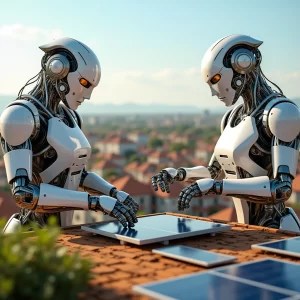
Once the immediate danger is mitigated, the focus shifts to rebuilding. In 2044, Autonomous Construction Robots take on the monumental task of restoring homes, infrastructure, and public spaces. These robots are equipped with 3D printing capabilities, allowing them to rebuild entire neighborhoods using advanced materials that are more resilient to future storms. Guided by the GAI’s master blueprint, they operate in perfect synchronization, building structures faster and more cost-effectively than any human crew ever could.
•3D-Printed Homes: Using a combination of lightweight composites and high-strength polymers, these robots construct homes in days rather than months, complete with integrated solar panels and flood-resistant foundations. Entire communities that were once left in ruin are rebuilt in weeks, providing displaced residents with permanent housing far more quickly than traditional construction methods would allow.
•Road and Bridge Repair: Construction robots, equipped with AI-powered excavators and autonomous cranes, rebuild critical infrastructure such as roads, bridges, and utility lines. They clear debris, pour concrete, and perform precision welding operations with unparalleled efficiency, making key transportation routes accessible again in record time.
AI-Driven Supply Chains: Delivering Essential Goods and Services
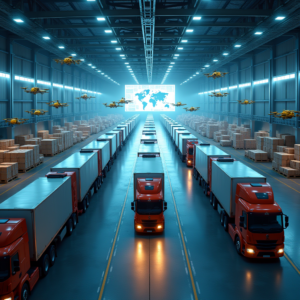 Coordinated by the GAI, a network of Autonomous Supply Drones and Trucks ensures that essential goods—such as food, water, medicine, and building materials—reach those in need without delay.
Coordinated by the GAI, a network of Autonomous Supply Drones and Trucks ensures that essential goods—such as food, water, medicine, and building materials—reach those in need without delay.
•Drone Fleets for Last-Mile Delivery: Small, agile drones deliver supplies directly to affected households, bypassing blocked roads and destroyed infrastructure. Using AI mapping and navigation, they pinpoint exact delivery locations, ensuring that families receive what they need, even in the most remote areas.
•Autonomous Trucks for Bulk Transport: Larger self-driving trucks transport bulk supplies to temporary distribution centers set up by construction robots. These trucks, guided by AI traffic management systems, optimize routes to avoid bottlenecks and minimize fuel consumption, ensuring a steady flow of aid to affected areas.
Healthcare and Emergency Services: AI-Powered Medical Support
In addition to physical infrastructure, disasters often overwhelm healthcare systems, leaving many without access to necessary medical care. AI-powered Autonomous Medical Units bridge this gap, providing rapid medical assistance to those in need.
•Mobile Clinics: Autonomous vehicles equipped with medical AI assistants and robotic arms serve as mobile clinics, diagnosing and treating injuries on-site. Using advanced diagnostics, these units can assess patient vitals, perform minor surgeries, and administer medications.
•Telemedicine Drones: In areas where human doctors are scarce, AI-powered telemedicine drones connect patients with remote healthcare professionals, providing real-time consultations and guidance. These drones can deliver specialized medicines, perform routine health checks, and even monitor chronic conditions.
The Superiority of AI-Driven Disaster Response Over Traditional Methods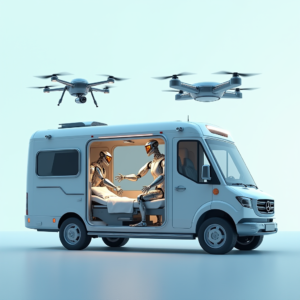
The difference between this future scenario and the current, human-led response systems is staggering. In today’s world, recovery from a major disaster is a slow, cumbersome process, hampered by bureaucratic inefficiencies, miscommunication between agencies, and limited resources. Organizations like FEMA do their best, but often lack the coordination, manpower, and speed necessary to handle large-scale disasters effectively.
In contrast, a GAI-coordinated response would provide:
•Unmatched Speed and Precision: Recovery efforts that once took months are completed in days, thanks to the 24/7 efficiency of autonomous systems.
•Dynamic Resource Allocation: AI’s ability to process real-time data means that resources are allocated precisely where they’re needed, reducing waste and ensuring that no one is left without support.
•Proactive Mitigation: The GAI not only responds to disasters—it anticipates them, using predictive modeling to deploy resources and personnel before a crisis even occurs.
•Greater Human Safety: Dangerous tasks, such as clearing debris, repairing power lines, and navigating floodwaters, are handled by robots, reducing the risk to human first responders.
A New Era of Resilient Communities: The Human Benefits of an AI-Driven Response
Beyond just restoring infrastructure and providing immediate relief, an AI and robotics-driven response has far-reaching benefits for society. By drastically reducing the time it takes to recover from a disaster, communities can avoid the long-term economic and social impacts that often accompany prolonged recovery periods.
•Reduced Economic Losses: Faster recovery means businesses can reopen sooner, residents can return to work, and local economies can rebound more quickly. The result is fewer bankruptcies, foreclosures, and long-term economic damage.
•Mental Health and Well-Being: Quick restoration of essential services such as power, water, and healthcare helps mitigate the psychological trauma often associated with disasters, allowing families to regain a sense of normalcy sooner.
•Strengthened Community Resilience: The GAI’s ability to rebuild stronger, more resilient infrastructure means that communities are better prepared for future storms. Flood-resistant homes, windproof utility lines, and self-sustaining power systems reduce the risk of repeated losses.
 Job Categories at Risk: Who Will Be Displaced?
Job Categories at Risk: Who Will Be Displaced?
In a world where AI and robots can take over complex disaster recovery efforts, it’s clear that entire categories of jobs are vulnerable to disruption. Let’s explore the occupations most at risk of being displaced or significantly altered by the rise of automation and advanced robotics, using our thought experiment as a guiding example.
1. Utility Workers and Infrastructure Technicians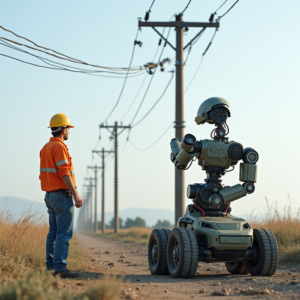
•At Risk: Electricians, water repair technicians, and utility line workers.
•Why They’re Vulnerable: The thought exercise illustrates how AI-guided utility repair robots can handle complex, high-risk tasks like power line restoration and water main repair. These robots are not only faster and more efficient, but they also eliminate the safety concerns associated with sending human workers into dangerous post-disaster environments.
•Potential Evolution: While the demand for traditional roles in this category may decline, new positions could emerge in maintaining and programming these repair robots, ensuring that they operate correctly and are properly deployed in the field.
2. First Responders and Rescue Teams
•At Risk: Search and rescue personnel, paramedics, and logistical support workers.
•Why They’re Vulnerable: In the scenario, AI-driven drones and autonomous rescue bots perform search and rescue operations with incredible speed and precision, covering more ground in hours than human teams could in days. This reduces the need for large, human-led rescue teams.
•Potential Evolution: These roles may shift from direct fieldwork to overseeing and managing drone swarms, coordinating with AI systems, and focusing on complex cases where human empathy and judgment are required.
3. Construction Workers and Manual Laborers
•At Risk: Construction workers, bricklayers, carpenters, and general contractors.
•Why They’re Vulnerable: The use of autonomous construction robots capable of 3D printing entire buildings is already becoming a reality. As these machines gain more capabilities, the demand for traditional construction labor will decline, particularly for repetitive, manual tasks.
•Potential Evolution: New roles could include supervising construction AI, programming and maintaining construction bots, or focusing on specialized craftsmanship that requires a human touch and aesthetic consideration.
4. Logistics and Transportation Workers
•At Risk: Truck drivers, delivery personnel, and warehouse workers.
•Why They’re Vulnerable: With self-driving trucks and drones handling both large-scale logistics and last-mile deliveries, traditional roles in transportation and warehousing will see significant changes. AI can optimize delivery routes and manage fleets of autonomous vehicles, reducing the need for human drivers and logistics planners.
•Potential Evolution: There will be a need for logistics coordinators who understand AI systems, as well as engineers who can troubleshoot autonomous vehicle technology.
5. Emergency Medical Personnel
•At Risk: Nurses, emergency medical technicians (EMTs), and doctors specializing in triage.
•Why They’re Vulnerable: In the futuristic scenario, mobile autonomous medical units provide rapid diagnostics and deliver essential medical care in the field. While the human element will always be needed for complex cases, many routine medical tasks could be automated.
•Potential Evolution: Medical professionals will need to adapt to roles that emphasize complex decision-making, human interaction, and emotional support, working alongside AI systems that handle routine assessments and emergency responses.
Workforce Mobility: Challenges and Opportunities
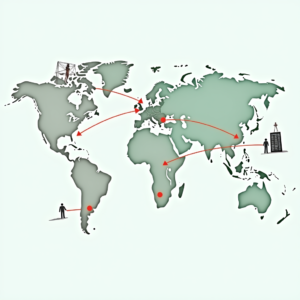 One of the greatest challenges of automation is workforce mobility—how quickly and effectively workers in at-risk occupations can transition into new roles. Historically, workforce transitions have been slow and painful, with displaced workers often taking years to find employment in new sectors. However, Mustafa Suleyman suggests that we have a unique opportunity to rethink this dynamic.
One of the greatest challenges of automation is workforce mobility—how quickly and effectively workers in at-risk occupations can transition into new roles. Historically, workforce transitions have been slow and painful, with displaced workers often taking years to find employment in new sectors. However, Mustafa Suleyman suggests that we have a unique opportunity to rethink this dynamic.
1. Reskilling for AI-Related Roles
The key to navigating occupational shifts will be proactive reskilling. Workers in vulnerable roles should be encouraged and supported to gain new skills in programming, AI management, robotics, and data science.
•Example: An electrician displaced by autonomous repair robots could transition into a robotics maintenance role, using their knowledge of systems and wiring to oversee and troubleshoot utility bots.
2. Emphasizing Human-Centric Skills
As technology handles more routine tasks, roles requiring human-centric skills—such as empathy, creativity, and critical thinking—will become more valuable. Industries like healthcare, social work, and education will continue to need human professionals who can provide emotional support and personalized care.
•Example: While routine diagnostics may be automated, nurses and therapists will be more essential than ever in offering human interaction and guidance in times of crisis.
3. Geographic Mobility and Regional Policies
Regional policies will need to address the geographical imbalances caused by automation. Rural areas heavily dependent on manufacturing and agriculture may suffer disproportionate job losses, while urban centers with diversified economies will see new opportunities.
•Example: Investment in “Resilience Centers” in rural areas could help at-risk workers transition to new roles, providing training, resources, and support for those affected by job displacement.
A Vision of Hope for the Future
The future of disaster recovery, guided by General Artificial Intelligence and powered by advanced robotics, offers a vision of hope and resilience. By combining the speed, efficiency, and adaptability of AI with the physical capabilities of autonomous machines, we can transform the way we respond to natural disasters. This future isn’t just about faster recovery—it’s about building a world where communities are stronger, more connected, and better able to withstand the storms ahead.
As we continue to develop these technologies, we must also consider the ethical and social implications. Who will control these AI systems? How will decisions be made? And how can we ensure that the benefits of these advancements are shared equitably? These are the questions we must answer as we move forward into this new era of AI-driven resilience.
In a world where natural disasters are becoming more frequent and severe, the ability to harness the power of AI and robotics could be the difference between chaos and recovery, between prolonged suffering and rapid relief. This is not just a technological dream—it is a necessity for a safer, more resilient future
Creating a Bulletproof Future: The Case for Digital Marketing and Network Marketing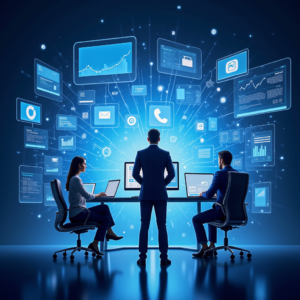
As workers face increasing uncertainty in traditional industries, a forward-thinking approach is to proactively build a financial future that is resilient to the waves of automation and economic disruption. One of the most accessible and rewarding pathways available today is through digital marketing and network marketing. By mastering digital skills and leveraging the unique benefits of a network marketing business model, individuals can create a future that is not only secure but also dynamic and scalable.
Why Digital Marketing?
Digital marketing represents the backbone of nearly every successful business in the modern era. From social media strategies and content creation to search engine optimization (SEO) and paid advertising, these skills are in high demand across industries. As automation reshapes traditional job markets, digital marketing offers the following distinct advantages:
•Versatility and Demand: Digital marketing is used by every business, from startups to multinational corporations. By learning these skills, individuals become valuable assets who can navigate a wide range of industries and business environments.
•Location Independence: Digital marketing can be done from anywhere with an internet connection. This offers incredible flexibility, allowing professionals to build businesses or support clients regardless of geographic location.
•Entrepreneurial Potential: With digital marketing expertise, anyone can create a profitable online business. Whether it’s building personal brands, managing marketing campaigns for other businesses, or selling digital products, the opportunities are limitless.
The Power of Network Marketing: Building a Resilient Income Stream
While digital marketing is essential, combining it with a network marketing business model can be a game-changer. Network marketing is a business structure that allows individuals to build their own enterprises by leveraging personal relationships, digital platforms, and scalable team-building strategies. Here’s why network marketing should be considered a vital component of a future-proof financial strategy:
•Scalability and Passive Income: In network marketing, the effort you put in today can pay dividends in the form of ongoing residual income. As you build a network of customers and business partners, your income grows exponentially—often with less hands-on effort required over time.
•Low Overhead, High Potential: Unlike traditional businesses, network marketing requires minimal upfront investment. With no need to maintain inventory or lease commercial space, you can start building a business from home with just a computer and an internet connection.
•Personal Development and Leadership: One of the unique aspects of network marketing is its emphasis on personal growth and leadership. As you grow your business, you also develop critical skills in communication, team management, and strategic planning—skills that are not easily automated.
•Human Connection in a Digital Age: While automation is disrupting industries, it cannot replace the value of human connection. Network marketing thrives on building trust and relationships, something that AI cannot replicate. As people seek more personalized experiences, those who master both digital marketing and relationship-building will be uniquely positioned for success.
How to Get Started: Combining Digital Marketing and Network Marketing
The synergy between digital marketing and network marketing is profound. By using digital tools to reach and engage a global audience, network marketers can amplify their impact, grow their teams faster, and create a business that is resilient to market fluctuations.
•Leverage Social Media: Platforms like Facebook, Instagram, and LinkedIn are ideal for sharing personal stories, promoting products, and attracting like-minded individuals to your business.
•Create Valuable Content: Use blogs, videos, and social media posts to provide value to your audience. Educate them about the benefits of your products and services, share success stories, and establish yourself as a trusted authority in your niche.
•Use Email Marketing: Build an email list to nurture leads and maintain regular contact with your audience. Offer free resources, training, and personalized messages to cultivate trust and encourage engagement.
•Automate Where Possible: Use digital marketing tools like scheduling apps, chatbots, and sales funnels to streamline repetitive tasks and free up time for high-level relationship-building.
The Bottom Line: Future-Proof Your Financial Success
In a world where the future of work is becoming increasingly uncertain, the ability to generate multiple income streams is invaluable. By mastering digital marketing and incorporating network marketing into your strategy, you create a business that is flexible, scalable, and capable of weathering the storm of technological disruption.
Taking the initiative now to develop these skills not only prepares you for whatever lies ahead but positions you to thrive in a rapidly changing economy. As technology advances, the most successful individuals will be those who combine the reach and efficiency of digital tools with the irreplaceable value of human relationships and entrepreneurial vision.
In our online course, Mastering the Art of Wealth Creation: A Journey Through Mind Power and Marketing, we delve deep into these strategies, offering you the guidance and resources to build a resilient, future-proof business. By equipping yourself with these skills today, you can create a financial future that is not just secure—but truly limitless.
Start building your path to financial freedom by exploring how digital marketing and network marketing can work together to create long-lasting wealth and success.
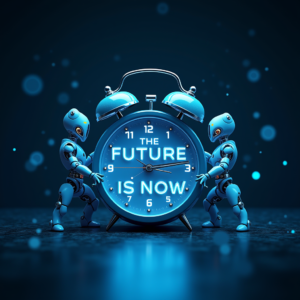 Conclusion: Wake Up to the Coming Disruption—Act Now to Secure Your Future
Conclusion: Wake Up to the Coming Disruption—Act Now to Secure Your Future
The future of work is evolving at a staggering pace. The disruptive forces of AI, robotics, and automation are not mere speculations—they are already transforming industries, reshaping economies, and impacting livelihoods around the world. To stay ahead, it’s essential to be fully informed and proactive in preparing for these changes. There’s no time to remain complacent in the face of such rapid technological advancement.
In our previous blogs, we explored the foundations of these shifts and the critical insights that every professional, entrepreneur, and individual should understand:
•“The Dawn of Automation: A Historical Perspective” provides a crucial understanding of how technological revolutions have shaped the workforce over the past centuries and the lessons we can draw from history to prepare for what’s coming. By examining the disruptive patterns of past eras, we can see the clear indicators of change repeating today. Don’t miss this foundational overview to understand the roots of what’s happening now.
•“Mapping the Workforce of Tomorrow” dives deep into which industries and job categories are most vulnerable to disruption. If you’re wondering whether your own job is at risk, this is the article you need to read. Understanding which sectors will thrive and which will fade is key to making informed decisions about your future career path.
•“The Automation Scenarios: Predicting the Impact” takes a closer look at different rates of AI and automation adoption—rapid, moderate, and slow. It analyzes what each scenario means for job displacement, the creation of new roles, and overall wealth distribution. Which scenario are we likely to see play out, and how can you prepare for the varying possibilities?
•“The Socioeconomic Impact of Workforce Displacement” reveals the broader consequences of automation, including how economic disparities could widen, regional inequalities may deepen, and what role government policies must play to mitigate these risks. It’s a sobering look at what’s at stake and why taking action now is more urgent than ever.
These blogs, along with the one you’re reading now, serve as a roadmap for navigating the complex terrain of the future of work. We’re not just witnessing a new era of technology—we’re witnessing the emergence of an entirely new economy. And only those who prepare themselves with the right skills, mindset, and strategies will be in a position to thrive.
Take Control: Start Preparing Now
Rather than being swept away by the waves of change, choose to ride them to new heights. Equip yourself with the knowledge to understand what’s coming and the skills to take advantage of the opportunities it presents. Our Mastering the Art of Wealth Creation course provides the blueprint you need to navigate this disruptive landscape confidently. You’ll learn how to harness digital marketing and network marketing strategies to create a resilient, future-proof financial plan.
Don’t wait until it’s too late—wake up to the coming disruption, act now, and secure your place in the future of work. Explore the full series, take proactive steps, and position yourself to not just survive but to lead and prosper in the age of AI, automation, and beyond.
#FutureOfWork, #Automation, #AI, #JobDisplacement, #DigitalMarketing, #NetworkMarketing, #Reskilling, #TechnologicalDisruption, #FutureProofCareers, #WealthCreation

John Rogers is a former Wall Street portfolio manager and served as CEO of Premium Enterprises and President of The Colorado Tire Recycling Center. He transitioned to digital marketing, founding WealthCreationMastermind.com to empower home-based entrepreneurs with cutting-edge strategies. Creator of the “Mastering the Art of Wealth Creation” online course, John has driven significant growth in network marketing, achieving the Blue Diamond rank and earning the title of Univera Associate of the Year in 2015. His expertise in leveraging technology for financial success transforms how entrepreneurs achieve their business goals.